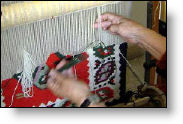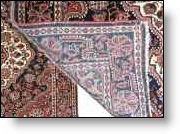Persian carpet
The name Persian carpet relates to the traditional origin of these carpets. Persian carpets have a long tradition in the area of what used to be Persia. Persia is the western name for the area which corresponds to today's Iran before March of 1935. Persian carpet is traditionally known for its variety in design, color, weave, and size. Each Persian carpet is unique. A Persian carpet can be used not only as a floor covering but also as a wall decoration.History of Persian carpet
 Persian carpets were probably first made by nomadic people. They used carpets to cover the floor in their tents. However, it is not certain who invented carpet making first, whether it was the nomadic Egyptians, or the Chinese. Some theories suggest that the art of carpet weaving is at least 3500 years old, but they are hard to prove. A few pieces of worn-out rugs have been discovered by archeologists in the area of Persia (today's Iran). These pieces are dated to be from the pre-Seljuk period which would be around 13th and 14th centuries BC. Some of the oldest pieces of Persian carpet have been found in Eastern Turkestan. These artifacts date to the 3rd to 5th centuries BC. Russian archaeologists Rudenko and Griaznov found in 1949 what seems to be the origin of today's Persian carpet in the Pazyryk valley. They found probably the oldest known "knotted" carpet. The Pazyryk valley is located in the Altai Mountains in Siberia at the elevation of about 5000 feet. Some of these remnants are being exhibited in the Museum of Turkish and Islamic Art in Istanbul and the Mowlana Museum in Konya.
Today, Persian carpet weaving is a widespread handicraft in Iran. For this reason, most carpets labeled as Persian carpet come from Iran. Persian carpet is renowned for their richness of color and for their variety of design and patterns.
Persian carpets were probably first made by nomadic people. They used carpets to cover the floor in their tents. However, it is not certain who invented carpet making first, whether it was the nomadic Egyptians, or the Chinese. Some theories suggest that the art of carpet weaving is at least 3500 years old, but they are hard to prove. A few pieces of worn-out rugs have been discovered by archeologists in the area of Persia (today's Iran). These pieces are dated to be from the pre-Seljuk period which would be around 13th and 14th centuries BC. Some of the oldest pieces of Persian carpet have been found in Eastern Turkestan. These artifacts date to the 3rd to 5th centuries BC. Russian archaeologists Rudenko and Griaznov found in 1949 what seems to be the origin of today's Persian carpet in the Pazyryk valley. They found probably the oldest known "knotted" carpet. The Pazyryk valley is located in the Altai Mountains in Siberia at the elevation of about 5000 feet. Some of these remnants are being exhibited in the Museum of Turkish and Islamic Art in Istanbul and the Mowlana Museum in Konya.
Today, Persian carpet weaving is a widespread handicraft in Iran. For this reason, most carpets labeled as Persian carpet come from Iran. Persian carpet is renowned for their richness of color and for their variety of design and patterns.
Persian carpet characteristics
Persian carpets come in a wide variety designs and styles. Wool, cotton, and silk are the types of carpet fiber most commonly used in Persian carpet. Persian carpets made out of silk are probably the most valuable ones, see Persian silk carpet and real silk test. The dyes used to create the coloring of a Persian carpet are usually natural. Although some manufacturers have been replacing the natural dyes with modern chemicals, the dyes in many true hand-made Persian carpets are still from plants, roots, and other natural substances. Because dyes are natural, subtle variations in the same color sometimes occur.How to recognize handmade Persian carpet

 How can you tell the difference between a fake Persian carpet and a real handmade Persian carpet? A real handmade Persian carpet exhibits some features that are distinct from a manufactured Persian carpet. There are ways to test a Persian carpet for being handmade. The first test is to turn the carpet upside down and look at the back. If you can see the pattern as clearly on the back as on the face of the Persian carpet (see the picture to the right), then it is likely a handmade Persian carpet. The next test is to bend the carpet to expose the roots of the pile. If you can see rows of knots at the base of the tufts, you are likely looking at a handmade Persian carpet. To see a picture of the difference between a handmade and a machine-made Persian carpet see here: machine-made vs. handmade rug. It can take even as many as 8 months to make a real handmade Persian carpet.
How can you tell the difference between a fake Persian carpet and a real handmade Persian carpet? A real handmade Persian carpet exhibits some features that are distinct from a manufactured Persian carpet. There are ways to test a Persian carpet for being handmade. The first test is to turn the carpet upside down and look at the back. If you can see the pattern as clearly on the back as on the face of the Persian carpet (see the picture to the right), then it is likely a handmade Persian carpet. The next test is to bend the carpet to expose the roots of the pile. If you can see rows of knots at the base of the tufts, you are likely looking at a handmade Persian carpet. To see a picture of the difference between a handmade and a machine-made Persian carpet see here: machine-made vs. handmade rug. It can take even as many as 8 months to make a real handmade Persian carpet.
Our carpet shopping guide can help you with your Persian carpet purchase. See our how to buy carpet guide here: how to buy carpet.